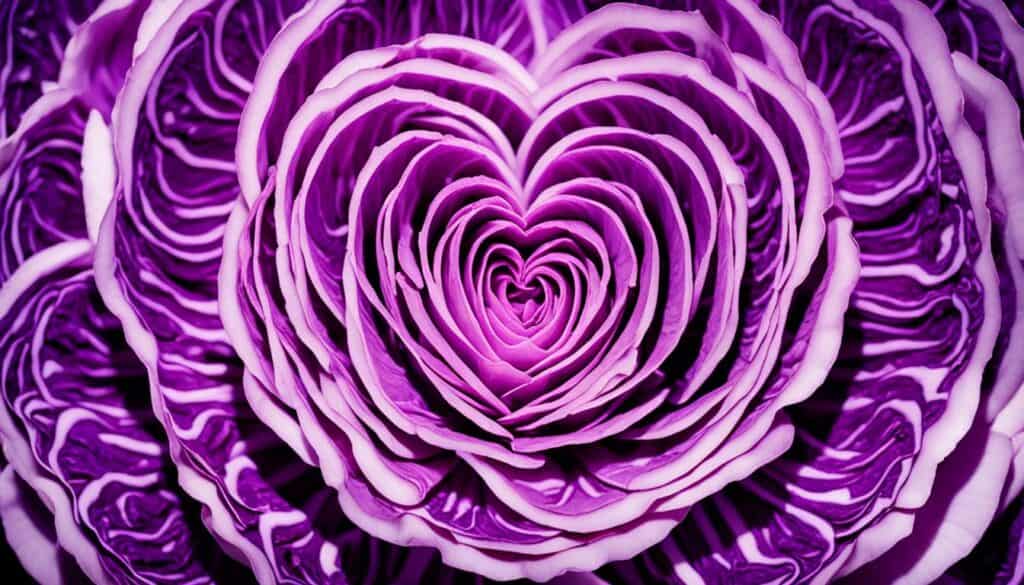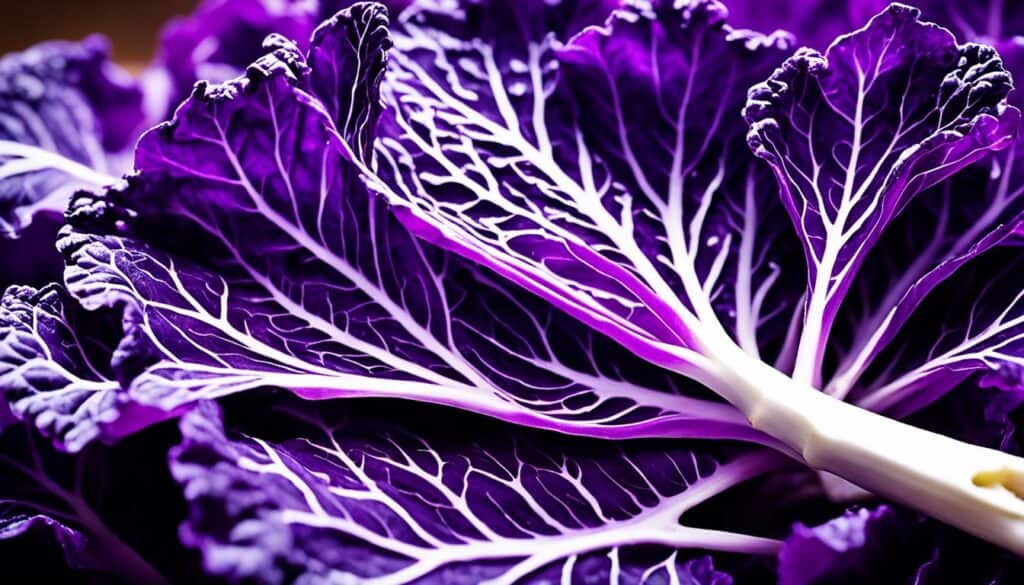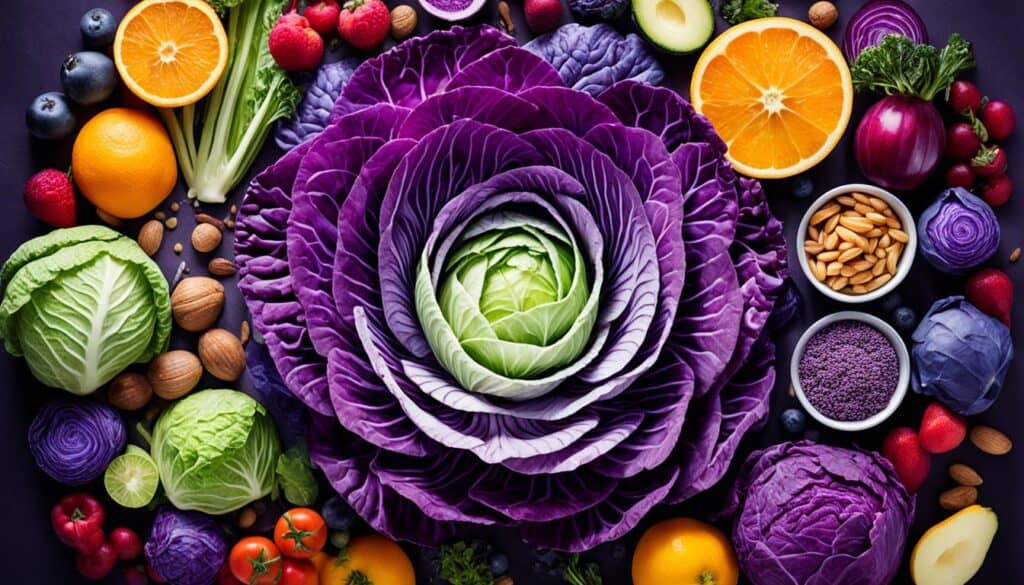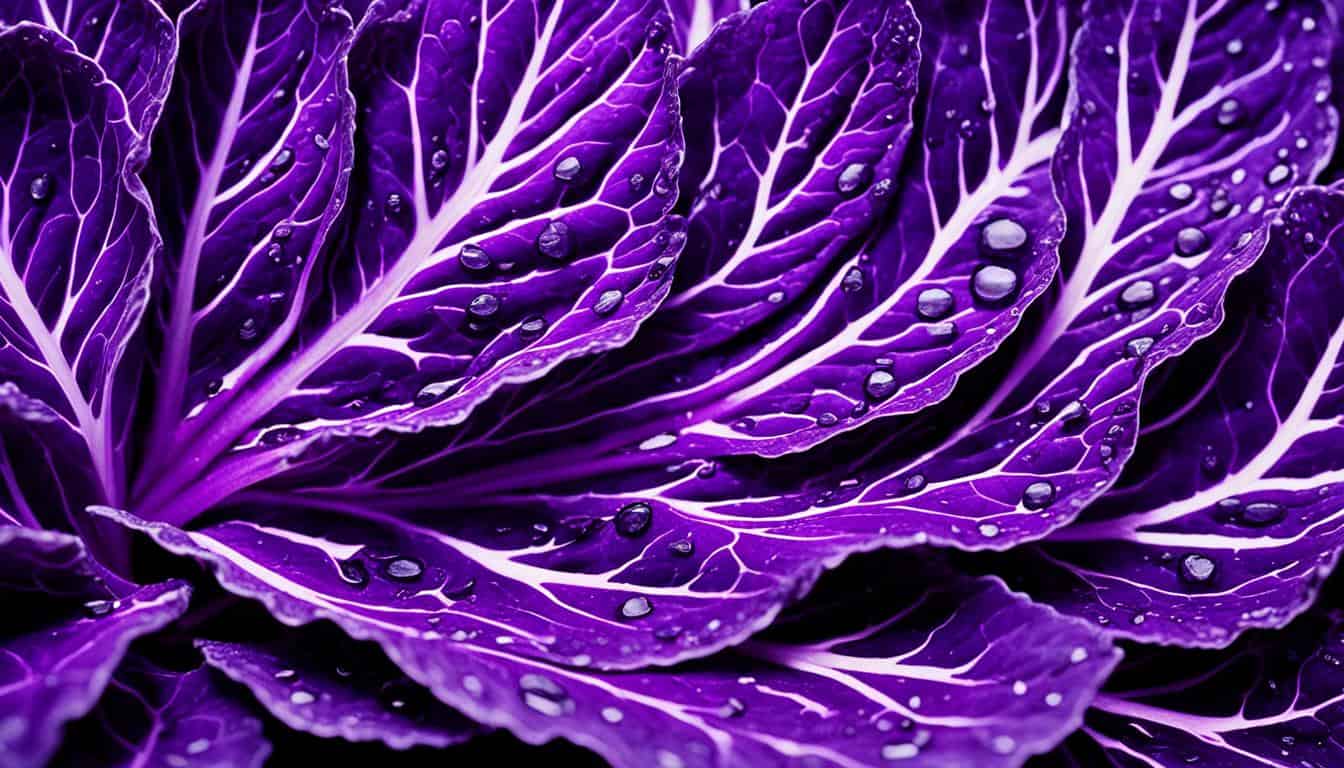Did you know that purple cabbage, also known as red cabbage, is not only a colorful addition to your plate but also a nutritional powerhouse? This vibrant vegetable offers a plethora of health benefits that can have a positive impact on your well-being. From reducing inflammation to supporting heart health and even potentially preventing certain types of cancers, purple cabbage is a versatile and beneficial addition to any diet.
Key Takeaways:
- Purple cabbage is low in calories but high in fiber and essential nutrients like vitamin C, vitamin K, and vitamin B6.
- It is rich in antioxidants, including anthocyanins, which have been linked to reduced inflammation, improved heart health, and potential protection against certain types of cancers.
- Purple cabbage is versatile and can be enjoyed raw, cooked, or fermented, making it a wonderful addition to a variety of dishes.
- Including purple cabbage in your diet can support bone health, promote gut health, and provide a host of essential nutrients.
- Try delicious recipes like purple cabbage coleslaw, sautéed purple cabbage, or purple cabbage soup to incorporate this nutritious vegetable into your meals.
Nutritional Profile of Purple Cabbage
One cup (89 grams) of chopped, raw purple cabbage contains 28 calories and a host of essential nutrients. It is an excellent source of vitamin C, providing 56% of the daily value. It also contains significant amounts of vitamin K, vitamin B6, and vitamin A. Purple cabbage is low in carbohydrates and fat but high in fiber, with 2 grams of fiber per cup. It also provides small amounts of iron, calcium, magnesium, phosphorus, copper, and zinc.
Purple cabbage is a nutrient-dense vegetable, making it an excellent addition to a balanced diet. Its high vitamin C content supports immune function, while vitamin K contributes to healthy blood clotting and bone health. Vitamin B6 is important for energy metabolism and brain development, and vitamin A promotes good vision and a healthy immune system.
| Nutrient | Amount per Cup (89g) |
|---|---|
| Calories | 28 |
| Vitamin C | 50 mg (56% of the daily value) |
| Vitamin K | 46.5 mcg (39% of the daily value) |
| Vitamin B6 | 0.1 mg (8% of the daily value) |
| Vitamin A | 71 mcg (8% of the daily value) |
| Fiber | 2 grams |
| Iron | 0.7 mg |
| Calcium | 27.9 mg |
| Magnesium | 12.2 mg |
| Phosphorus | 23.4 mg |
| Copper | 0.1 mg |
| Zinc | 0.2 mg |
With its low calorie content and high fiber content, purple cabbage is a great choice for weight management and digestive health. The fiber in purple cabbage adds bulk to the stool, helping promote regular bowel movements and prevent constipation. Additionally, its rich vitamin C content supports collagen production, which plays a crucial role in maintaining healthy skin, hair, and nails.
Powerful Plant Compounds in Purple Cabbage
Purple cabbage is not only packed with essential nutrients but is also rich in antioxidants and beneficial plant compounds that contribute to its vibrant color and potential health benefits. These powerful plant compounds provide protection against cellular damage and offer various health advantages.
Antioxidants in Purple Cabbage
Antioxidants play a crucial role in fighting against harmful free radicals in the body, which can cause cellular damage and contribute to chronic diseases. Purple cabbage contains high levels of antioxidants, including:
- Anthocyanins: These flavonoid antioxidants give purple cabbage its distinctive purple color and have been linked to numerous health benefits. They have anti-inflammatory and anti-cancer properties, support brain health, and contribute to heart health.
- Kaempferol: This flavonoid antioxidant is known for its anti-inflammatory, antimicrobial, and neuroprotective properties. It may also have potential cancer-fighting effects.
- Carotenoids: Purple cabbage is a good source of carotenoids, such as beta-carotene and lutein. These antioxidants help promote eye health, enhance immune function, and reduce the risk of certain chronic diseases.
Sulforaphane in Purple Cabbage
Another notable plant compound found in purple cabbage is sulforaphane. Sulforaphane is a sulfur-rich compound that has gained attention for its potential health benefits.
Sulforaphane has been associated with improved heart health and has shown promising results in cancer prevention and treatment due to its anti-inflammatory and anti-cancer properties.
Research suggests that sulforaphane may help reduce the risk of certain cancers and inhibit the growth of cancer cells. It activates enzymes that detoxify carcinogens, reducing their harmful effects on the body. Sulforaphane may also protect against heart disease by reducing oxidative stress and inflammation.
| Plant Compounds | Health Benefits |
|---|---|
| Anthocyanins | Anti-inflammatory properties, potential cancer prevention, improved heart health |
| Kaempferol | Anti-inflammatory, antimicrobial, potential cancer prevention |
| Carotenoids | Promote eye health, enhance immune function, reduce the risk of chronic diseases |
| Sulforaphane | Improved heart health, potential cancer prevention and treatment |
Reduced Inflammation with Purple Cabbage

Purple cabbage offers remarkable anti-inflammatory benefits that can help reduce inflammation throughout the body. Studies have shown that specific varieties of purple cabbage possess the ability to diminish markers of gut inflammation, promoting digestive health and overall well-being.
The secret to purple cabbage’s anti-inflammatory properties lies in a beneficial sulfur compound called sulforaphane. This compound, abundant in purple cabbage, has been found to play a crucial role in reducing inflammation.
Furthermore, the anti-inflammatory effects of purple cabbage extend beyond its consumption. Applying cabbage leaves directly to the skin can alleviate pain and reduce inflammation, particularly in conditions such as arthritis.
“Purple cabbage, with its anti-inflammatory properties, can be a natural remedy for reducing breast pain, swelling, and inflammation experienced during the early postpartum period.” – Expert Nutritionist
It’s remarkable to see the diverse ways in which purple cabbage can combat inflammation, both internally and externally. Whether consumed as part of a nutritious meal or utilized as a topical treatment, purple cabbage is a valuable ally in the battle against inflammation.
Heart-Healthy Benefits of Purple Cabbage

When it comes to promoting heart health, purple cabbage stands out as a superstar veggie. Its vibrant hue is not just visually appealing but indicative of its health benefits. Purple cabbage contains anthocyanins, which are flavonoid antioxidants responsible for its distinct color.
Research has shown that diets rich in anthocyanin-rich foods, like purple cabbage, can lower the risk of heart attacks and heart disease. These powerful compounds have been found to help protect against oxidative stress and inflammation, two key factors that contribute to cardiovascular problems.
Purple cabbage is a top contender when it comes to anthocyanin content. In fact, it contains over 36 different types of anthocyanins, making it an exceptional source of these heart-healthy antioxidants.
Regularly incorporating purple cabbage into your diet can help support a healthy heart and reduce the risk of cardiovascular disease. Whether it’s enjoyed raw in a refreshing salad or cooked in a delicious stir-fry, purple cabbage is a versatile vegetable that offers both taste and heart health benefits.
Purple Cabbage for Strong Bones

Purple cabbage is not only delicious but also highly beneficial for maintaining strong and healthy bones. It is packed with essential nutrients that support bone health, including vitamin K, calcium, magnesium, and zinc.
Vitamin K: Purple cabbage is rich in vitamin K, a vital nutrient for bone formation and maintenance. Vitamin K activates proteins that are responsible for binding calcium to bone mineral matrix, promoting bone strength and preventing conditions like osteoporosis.
Calcium: While purple cabbage provides smaller amounts of calcium compared to dairy products, every little bit counts. Calcium is crucial for building and maintaining strong bones, and even small additions to your daily intake can have a cumulative effect over time.
Magnesium: Purple cabbage also contains magnesium, which works in harmony with calcium to support bone health. Magnesium helps regulate calcium levels in the blood and plays a role in bone metabolism.
Zinc: Purple cabbage provides a modest amount of zinc, another essential mineral for bone health. Zinc plays a critical role in bone formation and supports the synthesis of collagen, a protein that gives structure to bones.
Including purple cabbage in your diet can help fortify your bones and reduce the risk of bone-related conditions. Whether you enjoy it in a salad, stir-fry, or sautéed, purple cabbage not only adds vibrant color to your meals but also provides valuable nutrients for your bone health.
Potential Cancer-Fighting Properties of Purple Cabbage
Purple cabbage, with its vibrant hue and crunchy texture, may hold promising cancer-fighting properties. Research suggests that incorporating cruciferous vegetables like cabbage into your diet may help lower the risk of colon and breast cancer. Purple cabbage, in particular, contains two key compounds that have attracted attention for their potential anti-cancer effects: sulforaphane and anthocyanins.
Sulforaphane, a sulfur-rich compound found in purple cabbage, has been studied for its ability to inhibit cancer cell growth and induce cell death. This compound activates specific enzymes in the body that help detoxify carcinogens and reduce oxidative stress, both of which are essential for cancer prevention.
Anthocyanins, the pigments responsible for purple cabbage’s vibrant color, are also being investigated for their potential anti-cancer properties. These powerful antioxidants have been shown to slow the growth of cancer cells and prevent their spread. Anthocyanins can also protect cells from DNA damage caused by harmful free radicals.
While the research on the cancer-fighting properties of purple cabbage is promising, it is essential to note that most studies have been conducted in test tubes or on animals. More research is needed to understand the full effects of purple cabbage on cancer prevention in humans.
“Purple cabbage contains sulforaphane and anthocyanins, two compounds that show promise in inhibiting cancer cell growth and preventing their spread.”
Despite the need for further research, adding purple cabbage to your diet can be a delicious and nutritious way to potentially reduce the risk of cancer. Its rich content of sulforaphane and anthocyanins makes it a valuable addition to a well-rounded, cancer-preventive lifestyle.
Gut Health Benefits of Purple Cabbage

Purple cabbage offers numerous gut health benefits, primarily due to its high fiber content. Fiber is essential for maintaining a healthy digestive system and supporting optimal gut function. Here are some ways purple cabbage can contribute to gut health:
- Improved Digestion: The fiber in purple cabbage aids in digestion by promoting regular bowel movements and preventing constipation. It adds bulk to stools, making them easier to pass through the digestive tract.
- Enhanced Gut Bacteria: The fiber in purple cabbage acts as a prebiotic, providing nourishment for the beneficial bacteria in the gut. These bacteria play a crucial role in maintaining gut health and supporting overall well-being.
- Reduced Inflammation: Purple cabbage contains soluble fiber, which helps reduce inflammation in the gut. This can be particularly beneficial for individuals with gut conditions like Crohn’s disease, irritable bowel syndrome (IBS), and ulcerative colitis.
Furthermore, purple cabbage’s fiber content supports feelings of fullness, aiding in weight management and preventing overeating. Incorporating purple cabbage into your diet is a delicious way to promote gut health and support overall well-being.
| Nutrient | Amount per Cup (89g) |
|---|---|
| Fiber | 2g |
| Vitamin C | 56% of Daily Value |
| Vitamin K | 28% of Daily Value |
| Vitamin B6 | 9% of Daily Value |
| Vitamin A | 4% of Daily Value |
| Iron | 4% of Daily Value |
| Calcium | 3% of Daily Value |
| Magnesium | 3% of Daily Value |
| Phosphorus | 3% of Daily Value |
| Copper | 3% of Daily Value |
| Zinc | 2% of Daily Value |
Delicious Recipes with Purple Cabbage

Purple cabbage is a versatile vegetable that adds vibrant color and a delightful crunch to various dishes. Whether you prefer it raw or cooked, there are numerous purple cabbage recipes that allow you to explore its delicious flavors. Here are a few mouthwatering options to try:
1. Purple Cabbage Coleslaw
This refreshing coleslaw combines the crispness of purple cabbage with a tangy dressing for a perfect side dish or salad. Simply shred purple cabbage, carrots, and onions, and toss them together with a creamy dressing made from mayonnaise, apple cider vinegar, honey, Dijon mustard, and a sprinkle of salt and pepper. Serve it chilled and enjoy the vibrant colors and flavors.
2. Sautéed Purple Cabbage
Turn purple cabbage into a tasty side dish by sautéing it with onions and garlic. Heat olive oil in a skillet, add sliced onions and minced garlic, and cook until they turn golden. Then, add thinly sliced purple cabbage to the skillet, season it with salt and pepper, and cook until it wilts slightly and turns vibrant in color. This simple yet flavorful dish pairs well with grilled meats or can be enjoyed on its own.
3. Purple Cabbage Soup
Warm up with a comforting bowl of purple cabbage soup. In a large pot, sauté chopped onions, carrots, and celery until tender. Add chopped purple cabbage, diced tomatoes, vegetable broth, and a selection of herbs and spices like thyme, bay leaves, and paprika. Simmer the soup until all the flavors meld together, and serve it hot with a sprinkle of fresh parsley on top. This nourishing soup is a delicious way to enjoy the health benefits of purple cabbage.
4. Purple Cabbage Kimchi
If you enjoy fermented foods, try making purple cabbage kimchi at home. Cut purple cabbage into bite-sized pieces and mix it with a paste made from garlic, ginger, Korean chili powder, fish sauce, and salt. Pack the mixture tightly into a jar and let it ferment at room temperature for a few days. The result is a tangy and spicy condiment that can be served alongside rice dishes, stir-fries, or as a flavorful addition to sandwiches and wraps.
5. Purple Cabbage Stir-Fry
Add a pop of color to your stir-fries by incorporating purple cabbage. Slice purple cabbage into thin strips and stir-fry it with your choice of vegetables like bell peppers, carrots, and snap peas. Add a sauce made from soy sauce, sesame oil, garlic, and ginger for an Asian-inspired flavor. Toss in some cooked protein like tofu, chicken, or shrimp, and serve the stir-fry over steamed rice or noodles for a satisfying meal.
These are just a few examples of the delicious ways you can incorporate purple cabbage into your meals. Get creative in the kitchen and experiment with different flavors and cooking techniques to discover new favorite recipes. Purple cabbage’s vibrant color and nutritional benefits make it a wonderful addition to any dish.
Possible Side Effects of Purple Cabbage
While purple cabbage is generally safe to eat, it is important to be aware of potential side effects that some individuals may experience. These side effects are usually mild and can include:
- Flatulence: Purple cabbage has a high fiber content, which can cause gas and bloating in some people.
- Thyroid Interference: Purple cabbage contains goitrogens, compounds that can interfere with thyroid function when consumed in excess. Individuals with thyroid conditions should consult their healthcare provider before consuming large quantities of purple cabbage.
- Allergic Reactions: Some individuals may be allergic to cabbage and may experience symptoms such as itching, swelling, or difficulty breathing. If you have a known cabbage allergy, it is best to avoid purple cabbage altogether.
It is important to note that these side effects are relatively rare and most people can enjoy purple cabbage without any adverse reactions. However, if you experience any discomfort or unusual symptoms after consuming purple cabbage, it is recommended to consult with a healthcare professional.
Now let’s explore some delicious recipes that incorporate purple cabbage.
Conclusion
In summary, purple cabbage is a versatile vegetable that not only adds vibrant color to your plate but also provides numerous health benefits. This nutrient-packed vegetable is low in calories but high in fiber, vitamins, and antioxidants. It can help reduce inflammation, support heart health, strengthen bones, and potentially even prevent certain types of cancers.
What makes purple cabbage truly unique is its versatility in the kitchen. Whether enjoyed raw in salads, lightly cooked in stir-fries, or fermented to make delicious kimchi, there are endless possibilities for incorporating purple cabbage into your meals.
By making purple cabbage a regular part of your diet, you can reap the health benefits while enjoying the delicious flavors it has to offer. So why not give this versatile vegetable a try and enhance your overall well-being?





Leave a Reply